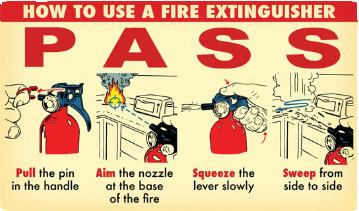



SHAYA FIRE | INTERESTING READING
Your safety should be your primary concern when attempting to fight a fire !
Which Extinguisher To Use
Fire extinguishers are divided into four categories, based on different types of fires. The following is a quick guide to help choose the right type of extinguisher.
Class A extinguishers are for ordinary combustible materials such as paper, wood, cardboard, and most plastics.
Class B fires involve flammable or combustible liquids such as fuel, kerosene, grease and oil.
Class C fires involve electrical equipment, such as appliances, wiring, circuit breakers and outlets. Never use water to extinguish class C fires - the risk of electrical shock is far too great! The C classification means the extinguishing agent is non-conductive.
Class D fire extinguishers are commonly found in a chemical laboratory. They are for fires that involve combustible metals, such as magnesium, titanium, potassium and sodium. - they are designed for class D fires only.

How to Fight a Fire Safely:
• Always stand with an exit at your back.
• Stand several feet away from the fire, moving closer once the fire starts to diminish.
• Use a sweeping motion and aim at the base of the fire.
• If possible, use a "buddy system" to have someone back you up or call for help if something goes wrong.
• Be sure to watch the area for awhile to ensure it doesn't re-ignite
•Remove clothing from the injured area. If any clothing sticks or adheres to the skin, simply cut around it and leave it in place for the paramedics to deal with.
•Keep the patient covered since there is a tendency for the victim to get the chills which could eventually lead to shock.
•Dressing or bandages for burns come in various forms (cotton gauze or synthetic bandages) and which kind to use depends on the type of burn wound
• If you find the victim is not responding, call 082 911 and then return to the victim.
• Tilt the victim’s head back and listen for any breathing. If they are not breathing or not breathing normally, pinch their nose and cover their mouth with yours. Blow until you see the chest rise and fall. Give two breaths of approximately two seconds each.
• If they are still not breathing, coughing or moving, start chest compressions. Push 1.5 to 2 inches on the chest about 15 times (between the nipples).
• Until the paramedics arrive, continue with two breaths and 15 chest compressions





